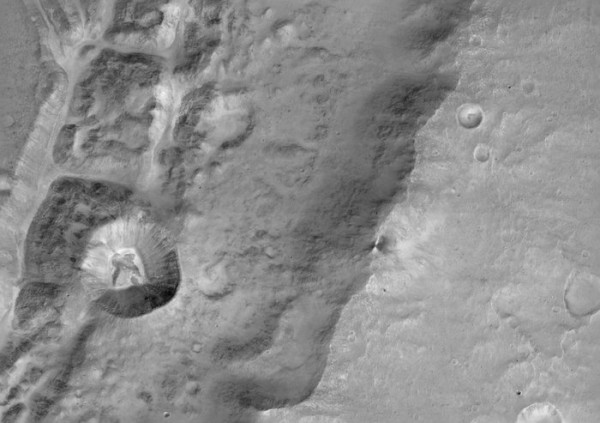By Ana Verayo, | November 30, 2016

Close-up of the rim of a large unnamed crater north of a crater named Da Vinci, situated near the Mars equator. (ESA/Roscosmos/ExoMars/CaSSIS/UniBE)
The European Space Agency's ExoMars mission has revealed the first of a series of photos of the Red Planet, which was captured by its Trace Gas Orbiter. The Schiaparelli lander may have been destroyed upon touchdown on Mars last month, but ESA's orbiting spacecraft is now providing the most unprecedented views of the alien world.
Like Us on Facebook
The TGO's CaSSIS (Colour and Stereo Surface Imaging System) camera obtained these photos during its first close flyby of Mars on November 22, at a distance of 146 miles above its dry and arid surface. The orbiter was flying over the Hebes Chasma region and over the northern valleys of Valles Marineris, which is a massive canyon system larger than Earth's.
According to ExoMars lead mission scientist, Nicolas Thomas of the University of Bern, the CaSSIS camera resolution was at 9.2 feet per pixel over the Hebes Chasma. He added that this is comparable to flying at 15,000 kilometers per hour and continuously snapping detailed photos of cars in Zurich.
Last week, the TGO completed two orbits around Mars to thoroughly test all of its onboard scientific instruments. These new photos are some of the most detailed ones that the spacecraft will ever capture, as it will return to its normal orbit at 249 miles above the surface of Mars.
Apart from these amazingly sharp photos, the TGO's instruments also successfully obtained measurements of the Martian atmosphere's water vapor content, including neutron activity around the Red Planet. Now, the ESA ExoMars mission team will proceed to build a new 3D model of the surface topography and terrain of Mars.
In the coming months, mission scientists plan to utilize the scientific suite of instruments onboard the TGO to study Martian seasons and transitional changes day by day. Apart from this, the TGO will also search for potential flowing liquid water on the surface of Mars and determine crucial trace gasses such as methane that can lead to potential life.
-
Use of Coronavirus Pandemic Drones Raises Privacy Concerns: Drones Spread Fear, Local Officials Say

-
Coronavirus Hampers The Delivery Of Lockheed Martin F-35 Stealth Fighters For 2020

-
Instagram Speeds Up Plans to Add Account Memorialization Feature Due to COVID-19 Deaths

-
NASA: Perseverance Plans to Bring 'Mars Rock' to Earth in 2031

-
600 Dead And 3,000 In The Hospital as Iranians Believed Drinking High-Concentrations of Alcohol Can Cure The Coronavirus

-
600 Dead And 3,000 In The Hospital as Iranians Believed Drinking High-Concentrations of Alcohol Can Cure The Coronavirus

-
COVID-19: Doctors, Nurses Use Virtual Reality to Learn New Skills in Treating Coronavirus Patients







